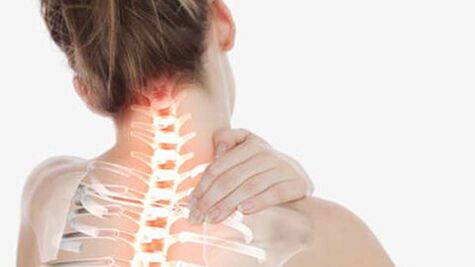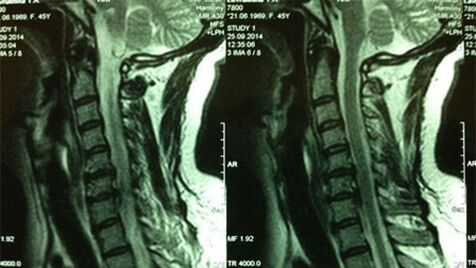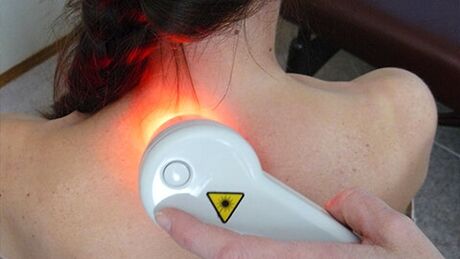
Cervical osteochondrosis is a progressive degenerative-dystrophic process that leads to exhaustion, deformity and destruction of the intervertebral discs of the cervical region.The loss of cartilage, absorbing shock, causes pain both due to the exposure to the joint surfaces (spondylartrosis) and because of the improvement of the nerve roots of the spinal cord.
In the absence of timely treatment, it is possible to worsen the spine with the loss of its natural flexibility, to disrupt the blood supply to the brain, the worsening of nerve conductivity in those parts of the body that innervate the roots of the cervical spine.
The pathology can develop both independently and as part of general damage to the spine with chest coating, lumbar and sacral parts.
General information
It is believed that osteochondrosis of the cervical spine is more common than in other departments.In fact, this is not the case - the dystrophic phenomena develop evenly at all points of the maximum load - in the area of the main turns of the spine (the less the department is located, the greater the load it carries).However, the symptoms of cervical osteochondrosis are more pronounced, so they look more common.This is due to the high mobility of the vertebrae of the neck, which at the same time holds the head, as well as the peculiarity of the outputs of the rotating roots of the spinal cord.
Note!According to statistics, the disease affects more than 60% of average and elderly people.Recently, however, there has been a rejuvenation of the pathological process - the pathology is found in young people and even in adolescents.This is due to the general computerization of the study and work, as well as to the reduction of physical activity and the deterioration of the quality of nutrition.
Given the age audience, 2 forms of cervical osteochondrosis can be distinguished - physiological and pathological.
Physiological processIt is associated with the natural aging of the body when the symptoms of the disease are a consequence of the gradual wear of the intervertebral discs.The process takes place under the endocrine system and is a consequence of menopause.The destruction of cartilage structures begins from the center of the intervertebral disc and is accompanied by a gradual replacement of the cartilage tissue of the fibers.The pathology is irreversible but can be offset by special medicines.
Pathological processIt is associated with abnormal destructive changes in the body - immune, dystrophic, inflammatory, metabolic.First of all, subcutaneous tissues involve salts of salts on bone structures, nerve roots appear, atrophy or hypertension of atrophy or skeletal muscles occur, leading to blood and grief.With timely diagnosis, the pathology is treated and ends with the complete restoration of the healthy function of the organs and tissues.
Stages of cervical osteochondrosis and their symptoms
There are 4 main stages of the pathological process:
- Stage 1st-is expressed by mild discomfort and muscle surge in the diseased area, cartilage discs lose their stability;
- Stage 2-Local pain appears, especially with head movements.The intervertebral discs are deformed, the fibrous ring begins to collapse, the distance between the vertebrae decreases;
- Stage 3-pain intensifies and becomes constant, the movement becomes limited.The heads of the head can cause dizziness, nausea, a disorder of the blood supply to the brain leads to general lethargy, rapid fatigue, impaired concentration, cartilage tissue is sharper, the vertebrae are closed, the fibrous ring is completely destroyed with the onset of the risk of intervertebral hernia;
- The fourth stage-pain syndrome completely immobilizes the neck area, the blood circulation of the brain is impaired and requires constant maintenance of the drug, the vertebrae begins to grow together.
Cervical osteochondrosis: signs, symptoms of pathology
In the first stages, osteochondrosis is asymptomatic.With the development of the disease, a distinctive feature is the presence of painful or uncomfortable sensations in the head, neck and chest, more rarely the upper limbs.
All possible symptoms can be conditionally attributed to 4 types of syndromes: heart, vertebra, roying (nervous) and spinal artery syndrome (with blood disorders).
Spine syndrome:
- crunch in the neck when rotating/tilting the heads;
- With the progress of the disease, there is pain and difficulty of movement;
- Morphological disorders of the structure in the body of the vertebrae and intervertebral space (visible to X -ray).
Cardiac syndrome:
- shortness of breath, weakness;
- Feeling of incomplete breath, lack of air;
- Spontaneous phenomena from the cardiovascular system-anggan pectoris, rag pain, burning;
Rook syndrome:
- tingling of tongue, shoulders, fingers, dorsal region;
- difficulty in swallowing;
- unpleasant sensations in the area between shoulder blades;
- Headache in the neck and forehead.
Vail Arttery Syndrome:
- unreasonable jumps in blood pressure;
- dizziness, to loss of consciousness;
- tinnitus, a feeling of cotton wool in the head;
- temporary blindness, "flies" in the eye;
- periodic attacks of nausea, especially with a title;
- Headache - mainly in the neck, as well as migraines;
- Dreaminess, reduction of productivity, memory, concentration of attention, depression.
Warning!All these syndromes should be combined with each other.The lack of symptoms of one of them can be the cause of differential diagnosis with other disease groups.
The causes of cervical osteochondrosis
The renewal phenomena in the cervical spine are related to the vertical location of the skeleton and the specific distribution of static and dynamic loads, which largely depend on the predominant poses and the degree of development of the skeletal muscles.
The main reasons:
- Lack of movement - what does not develop - degrades: muscles weaken, tissues are destroyed;
- Incorrect static poses - muscle brackets lead to blood disorders with subsequent tissue dystrophy;
- Lack of nutrition or unbalanced diet - the body should get everything necessary to build and renew the bone and cartilage structures of the skeleton, maintaining the muscle tone;
- Obesity, overweight, weight carrying - the load on the skeletal structure increases;
- constant nervous tension and nervous stress;
- The hypothermia of the cervical region - "caught", "inflated" - provokes hidden inflammatory processes;
- The presence of autoimmune diseases involving cartilage tissue leads to its premature destruction;
- Endocrine pathologies are confused by mineral metabolism, reduce the absorption of calcium, silicon, phosphorus and other elements of bone-criotic tissue;
- Injuries to the cervical region;
- Congenital spinal abnormalities and adjacent muscles.
Diagnostics

The diagnosis of "osteochondrosis of the cervical vertebra" is made up of the low specificity of the symptoms and a wide variety of their manifestations.In the course of the examination, consultation with a neurologist, surgeon, orthopedist, cardiologist will be required.
Physical examination is performed by a doctor with a patient examination.The main diagnostic load lies in instrumental and laboratory test methods.
Instrumental diagnostics:
- X -Ray of the cervical department;At the initial stage of the cervical department, the cervical department will be more information - it will provide high quality visualization of hard and soft tissues - it will show the condition of the intervertebral discs, the presence of osteophytes, deformities, damage to the nerve roots and blood vessels;will evaluate the condition of ligaments, muscles, bone tissue;
- Ultrasound shows the dynamic condition of soft tissues;
- Dopplerography of the vessels of the neck will help evaluate the hemodynamics and the degree of damage to the blood vessels (in particular the condition of the spinal artery);
- Contrasting myelography - will help to suspect nerve processes;
- ECG and heart echocardiography are used for differential diagnosis of cardiac syndrome with cardiovascular disease.
How to treat osteochondrosis of the uterus
The complex of medical measures is formed taking into account the stage of the disease (acute, chronic), the degree of damage and the causes of the development of the pathology.Use conservative treatment, surgery, mixed approach.
Conservative effect
This is a gradual recovery or compensation for damage to the background of symptomatic treatment.Includes drug therapy, physiotherapy, exercise and massage methods.
Medication:
- Painkillers - mainly gels and ointments with local influence;In severe cases - common painkillers in the form of tablets;
- anti -inflammatory drugs - NSAIDs, as well as corticosteroids (short course, if necessary);
- Medicines to improve microcirculation and circulation as a whole;
- Chondroprotectors - remedies for protection and repair of cartilage tissue;
- Missorelaxants - to eliminate muscle brackets and cramps;
- Vitamin and micro -complexes are required to feed and support the tissues by building elements.
Because acute symptoms are weakened, the methods of physiotherapy, exercise therapy and self -massage are related.
Therapeutic gymnasticsImproves the nutrition of cartilage and bone tissues by restoring blood supply to the damaged area.In order to avoid complications, it is recommended to use the method of isometric movements when, instead of real turns and slopes of the head that can damage, they use their imitation.
Warning!All actions should only be performed after diagnosis and consultation with a doctor.
The technique allows you to develop and strengthen the atrophied muscles of the short neck and stabilize the position of the cervical spine.The sequence of basic exercises:
- The palm of the right hand is reduced to the lateral surface of the head, press your palm on your head within 10 seconds, while tension of the muscles of the head and neck for resistance-head should remain stationary.
- Lower your hand, relax the muscles of the head and neck as much as possible in 20 seconds.
- Repeat the exercise with your left hand.
- Take your two hands with your palms in the forehead of the forehead for 10 seconds, as if you were trying to reject your head back while straining the muscles of the neck to resist movement.The head should remain stationary.
- Lower your hands, relaxing the muscles as similar to the previous exercise.
- Place both palms in the area above the back of the head.By analogy, perform a pressing load on the neck muscles, trying to tilt your head forward - it should still be stationary.
- Lower your hands, relax your neck and head muscles.Repeat the set of exercises 4-10 times.
After strengthening the muscles of the short neck, you can begin to perform dynamic exercises.
Note!As a methodology for restoring the mobility of the cervical region, swimming and water gymnastics, they turned out to be good.
Self -massageAllows you to reduce the intensity of local reactions and remove muscle brackets during static work.Rules to implement:
- Exposure area - the back of the head, back and side surfaces of the neck;
- performs the procedure in a sitting position;
- Movements must be carried out in the direction of the spine;
- Use only fingers;
- Avoid pressure on inflamed areas;
- Perform smooth movements - acute pressure can harm.

PhysiotherapyCharacteristic of stationary treatment and rehabilitation of the sanatorium-resource.Well proven yourself:
- Electrophoresis - hears the area, improves microcirculation, used for deeper penetration of local medicines;
- magnetotherapy;
- Amplipulse;
- UHF.
Surgical intervention is shown with complex extrusion, spinal cord disorders and syndromes of unconscious pain.
Than cervical osteochondrosis is dangerous
The neck area concentrates the dense intertwining of the main blood vessels, nerve processes and the dynamic structures of the bone skeleton.In the absence of treatment, serious pathological changes can be observed:
- Weakening of the fibrous ring causes dislocations and subluxation in the area of the most moving vertebrae;
- The presence of osteophytes and muscle encouragement leads to impaired nerve roots and blood vessels with the formation of compression syndromes;
- The destruction of cartilage discs and the rapprochement of the vertebrae leads to intervertebral hernias with disturbance of nerve tissue.
Each phenomenon follows a pronounced negative reaction from the whole body.
Possible complications and consequences
The list of the most common complications of cervical osteochondrosis can be included:
- vegetascular dystonia;
- hypertension;
- oxygen fasting of the brain and its structures;
- Dystrophy of the retina of the eyes with visual impairment;
- Thyroid malfunction;
- Interruption of esophageal and trachea functions - difficulty swallowing and breathing spasms;
- Unconscious syndrome of pain in the head, neck, chest, upper limbs;
- Convulsions and numbness of the face, hands;
- Disorders of the hypothalamic-pituitary system that pulls the failure of all the hormonal activity of the body.
Preventive measures
The most effective treatment is the prevention of the disease.Prevention will help you with that.It is enough to follow some basic recommendations:
- Adjust your stand
- Create a comfortable workplace;
- During the sedentary work, take a break for "physical education";
- Include in your dietary foods rich in calcium, magnesium, phosphorus, silicon - fish, nuts, seeds, legumes, dairy products, fresh vegetables, fruits;Limit the consumption of salt, sweet, flour and spicy dishes;
- For sleep and rest, use an orthopedic mattress and pillow;
- Take care of sports sports - it is better to give preference to swimming.
Even if you are not able to consider all the requirements, moderate physical activity, proper nutrition and careful attitude towards your posture can significantly reduce the risk of pathology.



































